How many times have you added the cutest dress in the world to your Amazon cart, only to realize when it arrives that the dress is too short, too tight, or the wrong shape for your body? The only way to buy or sew a dress that fits you is to match the dress to your shape. Fortunately, you can learn how to measure for a dress in just a few steps!
The three essential measurements for a dress are the circumference of the bust, waist, and hips at the fullest points of the body. Dress length, arm length for sleeves, and shoulder length for shoulder sleeve placement can also help determine the fit of a dress. In some cases, measuring the front and back length of the waistline can also impact the fit of a dress.
In this article, you will learn what dress sizes mean. You will find the nine important measurements you should take before making or buying a dress. Finally, you will discover how to measure a dress to determine its size.

Quick Navigation
- How Do You Measure a Woman for a Dress?
- How to Measure for a Dress: 9 Steps
- How to Measure a Dress Lying Flat
- How to Measure Yourself for a Dress Pattern
- Dress Size Calculator
- What is the Best Free Dress Measurement App?
- How to Measure for a Wedding Dress
- Where Can I Get Measured for a Dress?
- Dress Length Measurement Chart
- How to Measure a Dress to Sell
- Conclusion
How Do You Measure a Woman for a Dress?
The best way to measure for a dress is to get accurate bust, waist, and hip circumference measurements. You can then compare these to the sizing charts provided by most brands, online sellers, and clothing companies.
All you have to do is match your largest measurement (usually the hip circumference) to the matching hip measurement on the chart, and you will know what size to buy!
Of course, this can also help you weed out many dresses that would not fit you. If you find a hip measurement that matches you in the sizing chart, but the bust size in that column is way too small, you will know that the dress won’t fit your body.
Manufacturers typically only provide these three essential measurements for you to compare. This is because adding more variables forces them to make more shapes and sizes of clothing, which costs more.
But if you want to make your own dress or buy a custom-order wedding gown, you need to know various other measurements. These include things like a hollow-to-floor measurement and sleeve length.
If you can’t afford to order custom-made clothes designed for the shape of your body, you will have to use size charts and ready-wear clothing, though. Dresses in the United States come using two different generic sizing systems.
The first is the basic small, medium, and large system. It is important to note that no two brands or companies use the same measurements to determine these sizes. For example, a small dress from one brand might have a bust measurement of 33 inches, but a small from another brand might have a measurement of 33.5 inches or 34 inches.
The other commonly used dress size system in the United States is the even-number metric. This uses numbers ranging from 0 on up to describe the size of a dress.
While you can instantly guess that 0, 2, and 4 describe dresses on the smaller side and 16 and 18 describe dresses on the larger side, once again, you will not find a universal measurement used to assign these sizes. This is why you must consult sizing charts to match your measurements to the sizes each brand of clothing provides!
Finally, one other key factor to consider when you think about dress measurements is the style and fabric of the individual dress. Some types of dresses should fit much more tightly than others, so you may want to alter your measurements slightly if you want to wear a bodycon dress, for example.
Also, the type of fabric used may have more or less ease. Jersey knit fabric has a lot of ease because it will stretch around the shape of your body, but satin will not stretch and will not provide much ease. Dresses with a lot of natural ease in the fabric may fit you even in smaller-than-usual measurements because they will expand to fit your shape.
How to Measure for a Dress: 9 Steps
If you’re in a hurry, you can quickly measure for a dress by getting your bust, waist, and hips measurements. But it’s a good idea to measure all the key areas you may need to properly fit a dress and record them for future reference.
1. Neck

Ready-made clothing charts usually will not offer a neck measurement. But if you place an order for custom-made clothes on Etsy or Amazon, the seller will likely ask for this measurement to help provide the best neckline. You will also need a neck measurement if you sew a dress with a collar.
- Wrap a flexible tape measure around the back of your neck and gently bring it to the front till the ends of the tape meet up.
- Adjust the circle of the tape so that it sits above your collarbone or at the base of your neck.
- Finally, pull the tape lightly so that it rests firmly but not too tightly against your skin.
2. Bust
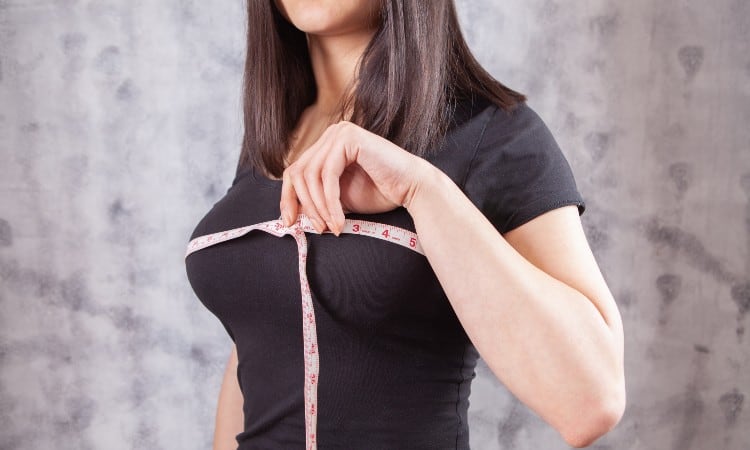
The bust, waist, and hip measurements give you the trifecta of essential numbers you have to know when making or buying a dress. Getting this one right makes all the difference!
If you don’t feel too uncomfortable, have someone help you with this one. You should wear the undergarments you plan to wear with the dress for the best results.
- If you have a helper, stand with your arms down at your sides, your feet slightly apart, and your shoulders relaxed. If you want to try this by yourself, you will get an almost-as-accurate measurement by positioning yourself in front of a mirror as you take the measurement.
- Wrap a flexible measuring tape around your back. If you have a helper, ask them to make sure the tape remains parallel to the floor as it crosses your upper back. If not, check the mirror to arrange the tape yourself.
- Bring the ends of the tape around to your front. Position them at the fullest/widest area of your bust.
- Pull the tape snug but not tight–you should not feel an indentation in your skin.
- Write down the number where the two ends of the tape meet.
3. Waist
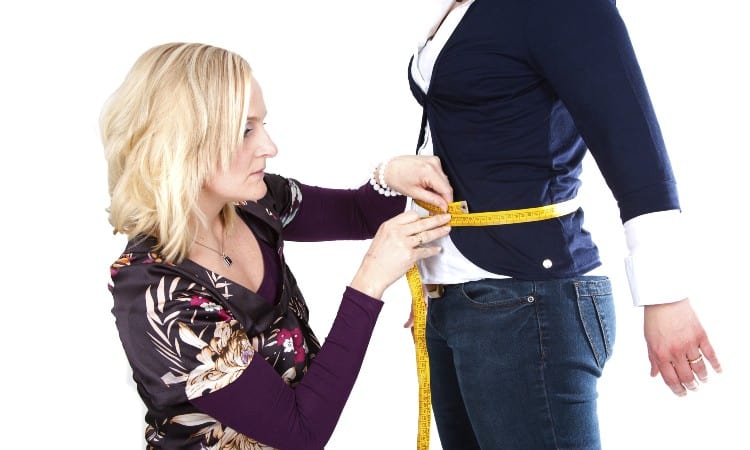
The waist in a dress performs the key role of highlighting your wider areas–your bust and your hips! But for a dress to display your waist to a good advantage, you need to take an accurate waist measurement. This means locating your natural waist.
- Stand in front of a mirror so you can see your back easily. Put your feet on the floor, breathe, and relax your shoulders.
- Now, locate the most narrow part of your torso using the mirror and your hands. Your natural waist occurs at a point somewhere right below your ribcage, and probably just above your navel. You want to measure the circumference of your body at this point.
- Wrap a flexible tape measure around you. Keep an eye on the mirror to make sure it does not sag or slip as it crosses your lower back.
- Note the number where the two ends of the tape meet at your waistline.
4. Hips
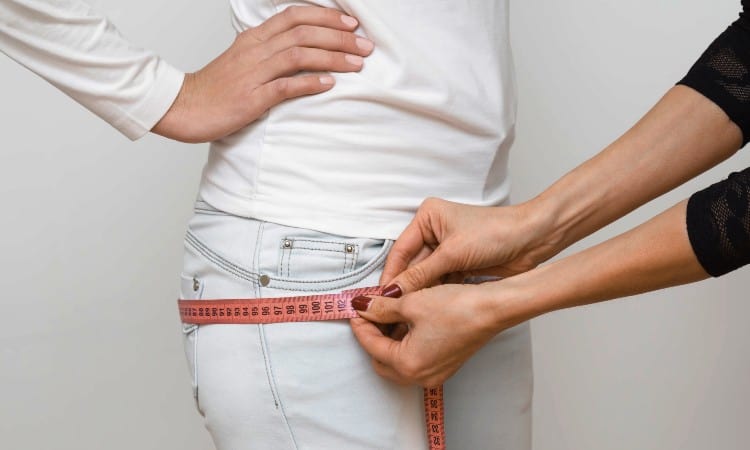
The key to getting a good hip measurement is to focus on the seat and the hip bones. This matters a lot because, for most women, the circumference of the hips is the widest point of the body. You should look for the hip measurement first when using a sizing chart for this reason!
- Once again, use a mirror to make sure you keep the tape level all the way around.
- Start by locating the widest area of your hips. You can often do this by finding the tips of your hip bones and circling this section of your torso. You can also look for the widest area of your seat, and use that as a starting point.
- Pin the short end of a tape measure at one hip, and use your other hand to be the tail of the tape all the way around you.
- Write down the measurement at the point where the two ends of the tape come together.
5. Front and Back Waist Length
Front and back waist length give you the distance from your shoulder to your waistline. This measurement does not play a large role in selecting off-the-rack clothes, but you’ll need it if you want to order custom clothes or sew your own!
For front waist length:
- Place the short end of a tape measure at your shoulder right where your neck meets your shoulder.
- Now drape the tape in a straight line down your front. Use your free hand to curve the tape with the contour of your body, over the fullest area of your bust, and down to your waistline.
- Write down this measurement.
For back waistline:
- Have a friend help you with this one, as you cannot easily reach these areas of your body by yourself!
- Stand looking straight ahead while your friend places one end of a flexible tape at the base of your neck, directly over your spine.
- Now ask your friend to smooth the tape down your back, following the curve of your spine. Stop when the tape reaches your waistline.
- Record this distance.
6. Shoulder
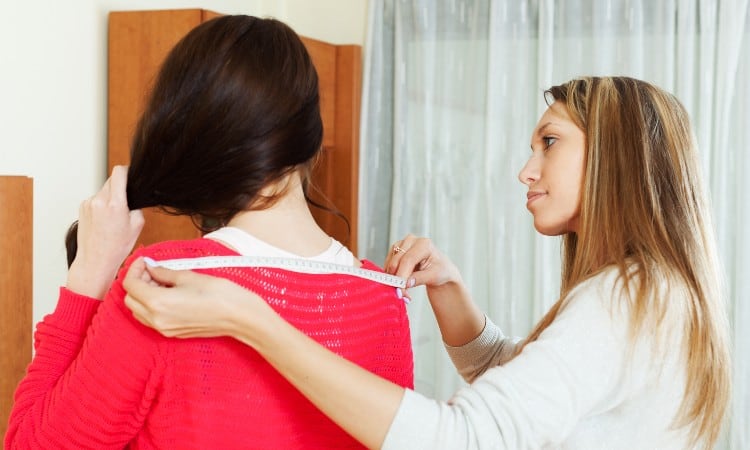
The shoulder length matters in a fitted coat-style or close-fitting sleeves style dress.
- If possible, wear a button-down shirt with a collar and cuffs that fit you perfectly. This will help you find the right points of your body to measure most easily.
- Place the short end of the tape at the base of your neck on one side.
- Runt eh tape across the length of your shoulder, and stop when you reach the end point of your shoulder. You can easily locate this endpoint by finding the shoulder seam in your fitted shirt!
- Write down this measurement.
7. Sleeve Length
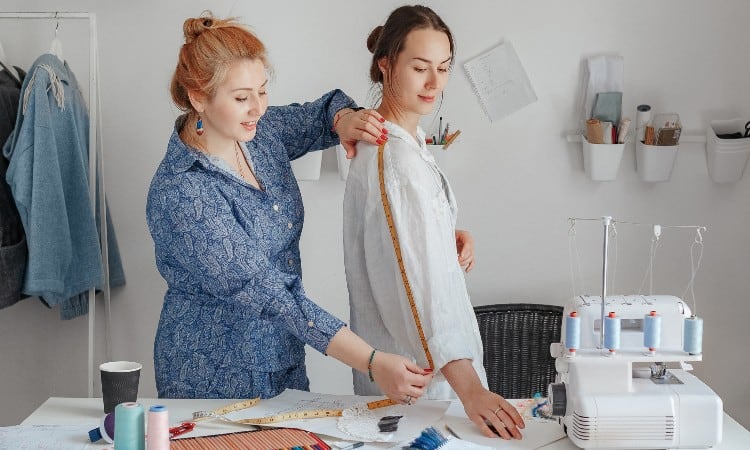
Sleeve length matters most in dresses with full-length sleeves. If you have a petite or tall frame with long arms, you may find it challenging to buy clothes with sleeves that reach the base of your hand and do not look too short or too long on your arms.
- Ask a friend to help. Don’t worry, you can wear a shirt during this measurement! Avoid any bulky or puffy clothing, though.
- Stand up straight but not too rigidly. Hold one of your arms loose and slightly bent at your side.
- Ask your friend to place the short end of the tape at your shoulder endpoint.
- Next, have your friend smooth the tape down your outer arm, bending with your elbow, and stopping at the base of your hand or the farthest side of the wristbone.
- Write down this measurement.
8. Length from Shoulder
A shoulder-to-hem measurement helps you know where the hem of the dress will fall on your body. Because bending over would ruin the measurement, it’s a good idea to have someone help you with this one!
When a sizing chart references the length of a dress, this is the measurement used most of the time.
- Stand straight with relaxed shoulders, hands open at your sides, and feet slightly apart on the floor.
- Ask a friend to place a tape measure in the center of your shoulder, with the tip of the tape at the top of the curve of your shoulder.
- Now ask them to let the tape fall.
- Mark the point you want the hem to end, such as your knees, ankles, or mid-thigh.
- Write down the distance from your shoulder to this point.
9. Hollow to Floor Length
A hollow-to-floor-length measurement is used mostly for wedding gowns. If you plan to order a wedding gown online, the seller will likely ask for this measurement. If you go to a shop like David’s Bridal, the associates will probably take this measurement for you.
A hollow-to-floor length measurement means the distance from the hollow at the base of your throat to the floor.
- You do not want to wear shoes for this measurement unless the seller specifically asks you to measure while wearing your wedding heels.
- Place the short end of the tape at the center of the hollow you can feel at the base of your throat. You can find this hollow right between your collarbones if that helps locate it.
- Keep the end of the tape in place with one hand, and allow the long end of the tape to fall to the floor.
- Make sure the tape forms a straight line.
- Write down the measurement at the point where the tape touches the floor.
How to Measure a Dress Lying Flat
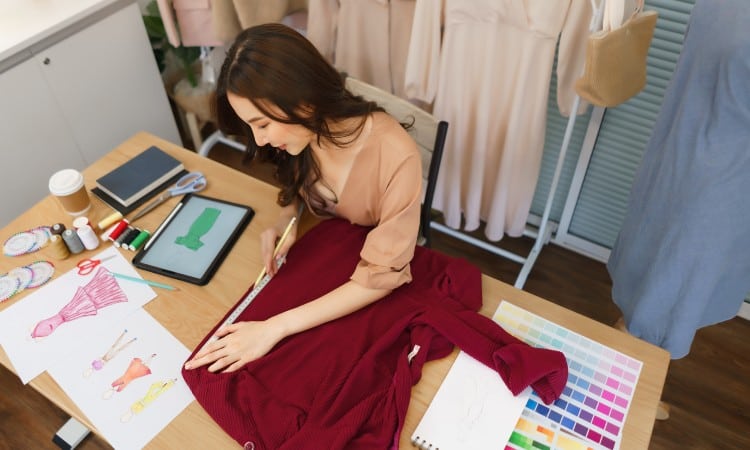
You can also get measurements by measuring across a dress lying flat. You may want to do this to see if a store-bought gown will fit you properly or write a product description to sell the garment.
- Start by gently steaming or ironing the dress, so it does not have any big creases. Then smooth it out flat on a broad surface like a table.
- Start by taking the bust measurement. Hold the short end of the measuring tape at one side seam where the bust looks the most full. Stretch the tape across to the other side seam, then double this measurement.
- Next, find the most narrow area of the waist, measure at that point from side seam to side seam, and double the measurement.
- To get a good hip measurement, your best bet is to measure eight inches down from the waistline. Mark this point and then measure straight across the dress from side seam to side seam at this point. Once again, double this to include both the front and the back of the dress and get the full circumference of the hip area.
- Finally, measure from the top of the shoulder to the hem to get the length. You do not need to double this measurement!
How to Measure Yourself for a Dress Pattern
You can measure yourself for a dress pattern using bust, waist, and hips circumference just as you would when you want to buy a dress. However, you may also need specialized measurements such as neck circumference if the dress pattern has a collar, or length measurements such as front length or back length if you have a long or short torso.
The good thing about sewing patterns is that they come with a sizing chart, at least most of the time! This means you can easily match your measurements to the correct size before cutting out your fabric.
Remember that the sizes offered on sewing patterns have nothing in common with the sizes you find on ready-wear clothes today. You may often wear a Size 4 dress off the rack, but when you measure yourself for a sewing pattern, you might need a Size 14! This is normal, so don’t worry about it.
Also, understanding the ease of your fabric is crucial when choosing a size of sewing pattern. If you want to make a dress out of plain-weave cottons, like gingham, it will not stretch much. This means you need room for your body parts to move around inside the garment.
But if you use a fabric such as a jersey knit, it will stretch easily around you, so you can sew it in a more fitted shape.
Dress Size Calculator
If sizing charts feel too overwhelming for you, you can also find free online dress size calculators to estimate what size will fit you based on your measurements.
If you try out the Omni Calculator, for example, you just have to type your bust, waist, and hip measurements in, and it will guess your size!
This is handy as a point of reference to tell you whether you should look at a size 10 or a size 2 when you shop for clothes in a store.
But honestly, size calculators do not give you the most accurate information. For that, you need to compare your specific measurements to a zing chart for each clothing brand. There is too much variation in sizing from one brand to another for you to just assume you always wear the same size of the dress.
What is the Best Free Dress Measurement App?
 Free dress measurement apps like TailorGuide can help you achieve the most accurate measurements and then understand how to match those measurements to the clothes you want to buy as you shop.
Free dress measurement apps like TailorGuide can help you achieve the most accurate measurements and then understand how to match those measurements to the clothes you want to buy as you shop.
This app assesses your measurements based on a series of pictures you take.
If you like having everything handily saved on your phone, you may want to try this app!
How to Measure for a Wedding Dress
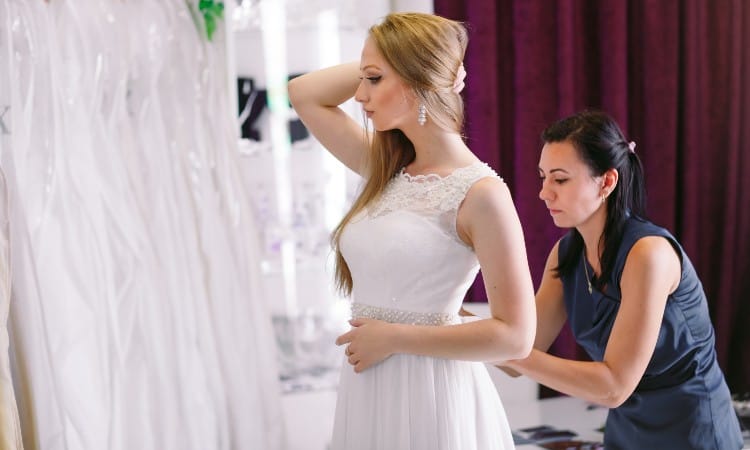
The best way to measure for a wedding dress is to get a professional such as a tailor or seamstress to take the measurements for you. Your wedding gown is a big investment and a huge part of one of the most special days of your life, so you don’t want to take any chances!
That said, of course, you can also take your own measurements, especially if you feel confident in your skills. You may want to do this if you plan to order a custom-made wedding dress from an online seller. The seller will always tell you what specific measurements they need in this case.
Depending on the style of wedding gown you want, you may need nothing more than your bust, waist, hip, and dress length measurements. Or you may need a whole list of measurements, including sleeve length, shoulder width, etc. The more complicated the gown, the more measurements you will need.
Where Can I Get Measured for a Dress?
You can get measured for a dress at most bridal salons, some department stores, and any seamstress, tailor, or dry cleaner that offers alterations.
One of the most popular places to get measured for a wedding gown or bridesmaid dress is David’s Bridal. This chain has stores practically everywhere, making it extra convenient. Some department stores like Nordstrom traditionally offer a free measuring service, but you may want to call ahead to check if this option is available at your local store.
The most traditional way to get professionally measured for a dress is to go to a tailor or seamstress. You can also find many small dry cleaning stores that offer alteration services, where the owner will know how to take your measurements professionally. Of course, you will need to pay or get an alteration done in this case!
Dress Length Measurement Chart
Check out this dress length chart to get an idea of all the different hem lengths you can find in different styles.
Dress length does not vary too much based on size, but it varies a huge amount based on the dress style. Dresses commonly come in many different lengths depending on the type and style of the garment.
As always, the exact measurement from waist to hemline can also vary from brand to brand, but this will give you a good idea of the average length used in popular styles of dresses.
| Dress Style | Distance from Waistline to Hemline | Distance from Shoulder to Hem |
| Mini Dress | 20” | 34-35” |
| Knee-Length | 25” | 39-40” |
| Midi Dress | 29” | 41-43” |
| Ankle-Length | 35” | 55-57” |
| Maxi Dress | 39” | 60-62” |
How to Measure a Dress to Sell
The best way to measure a dress to sell is to use the “how to measure a dress lying flat” method. You should also list the brand and size of the garment in your product description to give customers as much information as possible. You can often find this information on the manufacturer’s care label inside the dress.
If the dress does not have a tag inside, you can reverse-engineer your way into determining its size. Simply take all the measurements described in the “dress lying flat” method earlier in this article. Then look up a sizing chart for that brand, and find the size that correlates with the measurements you just took!
Conclusion
When you measure yourself for a dress, you will always need your bust, waist, and hip circumference at the widest section of these areas. Depending on the type of dress you want, you may also need to measure your neck circumference for a collar or sleeve length for a dress with full-length sleeves. For custom-order dresses, wedding gowns, or sewing patterns, you may also need specialty measurements such as the hollow-to-floor length.
If you want to measure a dress instead of measuring yourself, spread the garment out flat. Measure from sideseam to sideseam at the bust, waist, and hips. Then make sure to double these measurements to include the distance across the front and back of the dress.